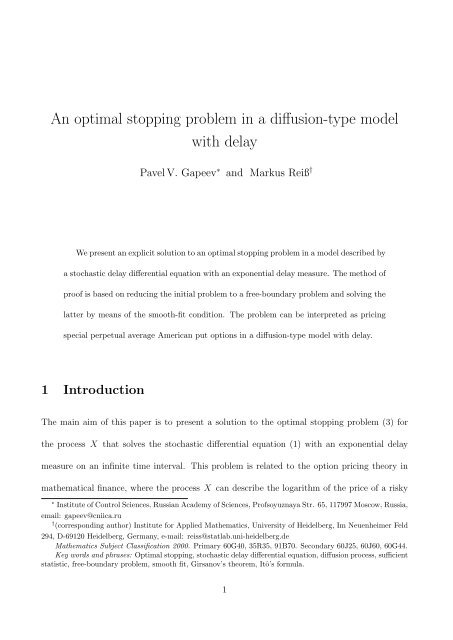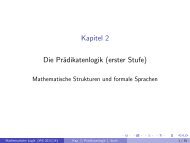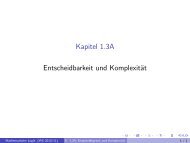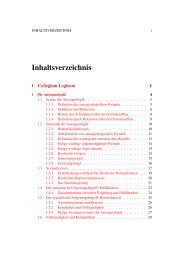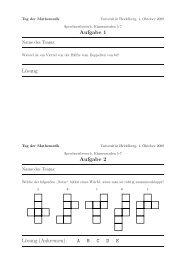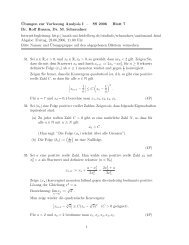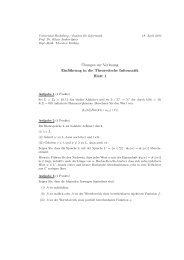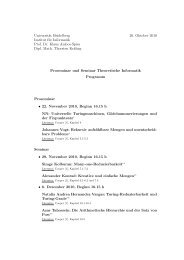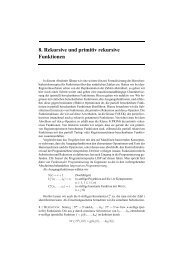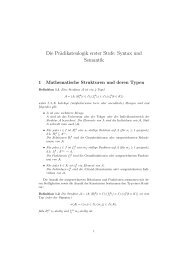An optimal stopping problem in a diffusion-type model with delay
An optimal stopping problem in a diffusion-type model with delay
An optimal stopping problem in a diffusion-type model with delay
Create successful ePaper yourself
Turn your PDF publications into a flip-book with our unique Google optimized e-Paper software.
where B ∗ is the largest number from 0 < z ≤ log K such that V ∗ (z) = Ke −z − 1. The po<strong>in</strong>tB ∗ is called an <strong>optimal</strong> <strong>stopp<strong>in</strong>g</strong> boundary. Note that if K ≤ 1 and z > 0 then the <strong>problem</strong>(16) becomes trivial, so that we further assume that K > 1.2.3. Standard arguments based on the application of Itô’s formula (see e.g. [12; Theorem7.3.3]) imply that <strong>in</strong> this case the <strong>in</strong>f<strong>in</strong>itesimal generator L of the process Z acts on afunction F ∈ C 2 (0, ∞) like:(LF )(z) = −(3θ 2 /2) z (z + 2λ/(3θ 2 )) F ′ (z) + (θ 2 /2) z 2 F ′′ (z) (18)for all z > 0. In order to f<strong>in</strong>d the unknown value function V ∗ (z) from (16) and the unknownboundary B ∗ from (17), we refer to the general theory of <strong>optimal</strong> <strong>stopp<strong>in</strong>g</strong> <strong>problem</strong>s for cont<strong>in</strong>uoustime Markov processes (see e.g. [6] and [18; Section III.8]) and formulate the follow<strong>in</strong>gfree-boundary <strong>problem</strong>:(LV )(z) = δV (z) for z > B (19)V (B+) = Ke −B − 1 (cont<strong>in</strong>uous fit) (20)V (z) = (Ke −z − 1) + for z < B (21)V (z) > (Ke −z − 1) + for z > B (22)where 0 < B ≤ log K and (20) plays the role of an <strong>in</strong>stantaneous-<strong>stopp<strong>in</strong>g</strong> condition. Observethat the superharmonic characterization of the value function (see [3] and [18]) implies thatV ∗ (z) is the smallest function satisfy<strong>in</strong>g (19)-(22) <strong>with</strong> the boundary B ∗ .Because of thecont<strong>in</strong>uity of the process Z we also assume that the follow<strong>in</strong>g condition holds:V ′ (B+) = −Ke −B (smooth fit). (23)7
obta<strong>in</strong> the follow<strong>in</strong>g equalities:(C 1 B γ U γ, 2γ − 2λ )θ ; 3B = Ke −B − 1 (28)2(γC 1 B γ−1 U γ, 2γ − 2λ )(θ ; 3B − 3γC 2 1 B γ U γ + 1, 2γ − 2λ )θ + 1; 3B = −Ke −B . (29)2By solv<strong>in</strong>g equations (28)-(29) it therefore follows that the solution of system (19)-(20)+(23)is given by:V (z; B ∗ ) = ( Ke −B∗ − 1 )( zB ∗) γ U(γ, 2γ − 2λ/θ 2 ; 3z)U(γ, 2γ − 2λ/θ 2 ; 3B ∗ )(30)for all z > B ∗ , where B ∗ satisfies the transcendental equation:γ 3B U(γ + 1, 2γ − 2λ/θ2 + 1; 3B)U(γ, 2γ − 2λ/θ 2 ; 3B)− γ =KBe−BKe −B − 1 . (31)3.2. In order to prove the existence and uniqueness of the solution of equation (31) on the<strong>in</strong>terval (0, log K), let us denote by G(B) the left-hand side and by H(B) the right-hand sideof equation (31). Then H(B) is a strictly <strong>in</strong>creas<strong>in</strong>g function on (0, log K) <strong>with</strong> H(0+) = 0and H(log K−) = ∞. Thus, if we deduce that G(B) is a decreas<strong>in</strong>g function on (0, log K)such that G(0+) > 0, then we will be able to conclude that there exists a unique solution B ∗of equation (31) on the <strong>in</strong>terval (0, log K).To prove G(0+) > 0, let us note that by apply<strong>in</strong>g the change-of-variable formula to (26) itfollows that:U(a, b; z) = z1−bΓ(a)∫ ∞0e −u u a−1 (u + z) b−a−1 du, (32)which directly implies:z U(a + 1, b + 1; z)limz↓0 U(a, b; z)=Γ(a)Γ(b)Γ(a + 1)Γ(b − 1) = b − 1a(33)9
for any b > a + 1 > 1 fixed. Hence, <strong>in</strong>sert<strong>in</strong>g a = γ and b = 2γ − 2λ/θ 2 as well as z = 3B <strong>in</strong>to(33), for the left-hand side of (31) we get:lim G(B) = lim γ 3B U(γ + 1, 2γ − 2λ/θ2 + 1; 3B)B↓0 B↓0 U(γ, 2γ − 2λ/θ 2 ; 3B)− γ = γ − 2λ − 1 > 0. (34)θ2 To derive the monotonicity of G(B), let us observe that from representation (32) it followsthat:z U(a + 1, b + 1; z)U(a, b; z)=∫ ∞∫e −u u a (u + z) b−a−1 ∞du0a ∫ ∞e0 −u u a−1 (u + z) b−a−1 du = u(u + z)f0 z (u) dua ∫ ∞(u + z)f 0 z(u) du , (35)where f z (u) = C(z)e −u u a−1 (u + z) b−a−2 , u ≥ 0, is a probability density <strong>with</strong> some normaliz<strong>in</strong>gconstant C(z) for any b > a + 1 > 1 fixed. Then, apply<strong>in</strong>g the Cauchy-Schwarz or Jensen<strong>in</strong>equality and tak<strong>in</strong>g <strong>in</strong>to account the fact that b − a − 1 > 0, we obta<strong>in</strong>:( )d z U(a + 1, b + 1; z)(36)dz U(a, b; z)= (b − a − 1) (∫ ∞uf0 z (u) du ∫ ∞(u + z)f 0 z(u) du − ∫ ∞u(u + z)f0 z (u) du ∫ ∞f0 z (u) du )( ∫ ∞a (u + z)f 0 z(u) du ) 2≤ (b − a − 1) (∫ ∞u 2 f0 z (u) du + z ∫ ∞uf0 z (u) du − ∫ ∞u(u + z)f0 z (u) du ∫ ∞f0 z (u) du )( ∫ ∞a (u + z)f 0 z(u) du ) 2= 0.Thus, sett<strong>in</strong>g a = γ and b = 2γ − 2λ/θ 2 as well as z = 3B , we may conclude that G(B), be<strong>in</strong>gthe left-hand side of (31), is decreas<strong>in</strong>g on (0, log K). This completes the proof of uniqueness.3.3. So far, we have seen that V (z) = V (z; B ∗ ) satisfies equation (19), and conditions (20)and (23) hold <strong>with</strong> B = B ∗ . Let us now show that <strong>in</strong>equality (22) is also satisfied. For this,we take logarithms on both sides of (22) and observe that, <strong>in</strong> view of equality (20) and the factthat V (z; B ∗ ) is positive, it suffices to verify the <strong>in</strong>equality:ddz log V (z; B ∗) > d dz log(Ke−z − 1) (37)10
for B ∗ < z < log K . By us<strong>in</strong>g the def<strong>in</strong>ition of V (z; B ∗ ) <strong>in</strong> (30) and (31), it is straightforwardto see that <strong>in</strong>equality (37) is equivalent to:γ 3z U(γ + 1, 2γ − 2λ/θ2 + 1; 3z)U(γ, 2γ − 2λ/θ 2 ; 3z)− γ 0 and assume that K > 1.Then the value function of the <strong>problem</strong> (16) takes the form:⎧⎪⎨ V (z; B ∗ ), if z > B ∗V ∗ (z) =(39)⎪⎩ Ke −z − 1, if z ≤ B ∗and the <strong>optimal</strong> <strong>stopp<strong>in</strong>g</strong> time τ ∗ has the structure (17), where the function V (z; B ∗ ) is givenby (30) and the boundary B ∗ is the unique solution of the transcendental equation (31).Proof. It rema<strong>in</strong>s to show that the function (39) co<strong>in</strong>cides <strong>with</strong> the value function (16)and that the <strong>stopp<strong>in</strong>g</strong> time τ ∗ from (17) <strong>with</strong> the boundary B ∗ specified above is <strong>optimal</strong>. Letus denote by V (z) the right-hand side of the expression (39). It follows by construction fromthe previous section that the function V (z) solves the system (19)-(22), and condition (23) is11
satisfied. Thus, apply<strong>in</strong>g Itô’s formula to e −δt V (Z t ), we obta<strong>in</strong>:e −δt V (Z t ) = V (z) +where the process (˜M t ) t≥0 def<strong>in</strong>ed by:˜M t =∫ t0∫ t0e −δs (LV − δV )(Z s ) ds + ˜M t , (40)e −δs V ′ (Z s ) θZ s d˜W s (41)is a cont<strong>in</strong>uous local mart<strong>in</strong>gale under ˜P z . Observe that the time spent by the process Z atthe boundary B ∗ is of Lebesgue measure zero, which allows to extend (LV −δV )(z) arbitrarilyto z = B ∗ .Due to the properties (20)-(23), a Taylor expansion shows that V ′′ (B ∗ −) ≤ V ′′ (B ∗ +) holds,which by the form of the generator <strong>in</strong> (18) directly implies that (LV − δV )(B ∗ −) ≤ (LV −δV )(B ∗ +) = 0. Moreover, it can be checked that:ddz (LV − δV )(z) = −(LV − δV )(z) + (4θ2 + λ)Ke −z + δ (42)for all 0 < z < B ∗ , from where we may conclude that (LV − δV )(z) is <strong>in</strong>creas<strong>in</strong>g and thusnegative on (0, B ∗ ). This together <strong>with</strong> (19) yields (LV − δV )(z) ≤ 0 for all z > 0. Fromexpression (40) it therefore follows that the <strong>in</strong>equalities:e −δτ ( Ke −Zτ − 1 ) +≤ e −δτ V (Z τ ) ≤ V (z) + ˜M τ (43)hold for any f<strong>in</strong>ite <strong>stopp<strong>in</strong>g</strong> time τ of the process Z started at z > 0. Let (σ n ) n∈Nbe anarbitrary localiz<strong>in</strong>g sequence of <strong>stopp<strong>in</strong>g</strong> times for the process (˜M t ) t≥0 . Tak<strong>in</strong>g <strong>in</strong> (43) theexpectation <strong>with</strong> respect to the measure ˜P z , by means of the optional sampl<strong>in</strong>g theorem (seee.g. [7; Theorem I.1.39] or [16; Theorem II.3.2]), we get:Ẽ z[e ( −δ(τ∧σn) Ke −Zτ∧σn − 1 ) ] + [≤ Ẽz e−δ(τ∧σ n) V (Z τ∧σn ) ] (44)≤ V (z) + Ẽz[˜Mτ∧σn]= V (z)12
for all z > 0. Hence, lett<strong>in</strong>g n → ∞ and us<strong>in</strong>g Fatou’s lemma, we obta<strong>in</strong> that for any f<strong>in</strong>ite<strong>stopp<strong>in</strong>g</strong> time τ the <strong>in</strong>equalities:Ẽ z[e −δτ ( Ke −Zτ − 1 ) + ] ≤ Ẽz[e −δτ V (Z τ ) ] ≤ V (z) (45)are satisfied for all z > 0.By virtue of the fact that the function V (z) together <strong>with</strong> the boundary B ∗satisfy thesystem (19)-(22), by the structure of the <strong>stopp<strong>in</strong>g</strong> time τ ∗<strong>in</strong> (17) and by expression (40) itfollows that the equality:e −δ(τ∗∧σn) V (Z τ∗∧σ n) = V (z) + ˜M τ∗∧σ n(46)holds. Then, us<strong>in</strong>g the expression (43) and the fact that the function V (z) is decreas<strong>in</strong>g, we<strong>in</strong>fer the <strong>in</strong>equalities:−V (z) ≤ ˜M τ∗∧σ n≤ V (B ∗ ∧ z) − V (z) (47)for all z > 0. Note that from (11) it follows that Z t tends to zero as t → ∞ ( ˜P z -a.s.), and thelatter fact implies that for the <strong>stopp<strong>in</strong>g</strong> time (17) we have ˜P z [τ ∗ < ∞] = 1 for all z > 0. Hence,lett<strong>in</strong>g n → ∞ <strong>in</strong> (46) and us<strong>in</strong>g conditions (20)-(21) as well as the property V (B ∗ ∧ z) < ∞,we can apply the Lebesgue dom<strong>in</strong>ated convergence theorem to obta<strong>in</strong> the equality:Ẽ z[e −δτ∗ ( Ke −Zτ∗ − 1 ) + ] = V (z) (48)for all z > 0, which together <strong>with</strong> (45) directly implies the desired assertion. □Remark 4.2.Let us briefly consider the dependence of the solution on the deviationparameter λ, which reflects the impact of the <strong>delay</strong>. For this, let us denote by V ∗ (z; λ) thevalue function from (16) and by B ∗ (λ) the <strong>optimal</strong> <strong>stopp<strong>in</strong>g</strong> boundary from (17), where we13
underl<strong>in</strong>e the dependence on λ. Then, by the comparison theorem for stochastic differentialequations applied to (10) and by the structure of the value function (16) it follows that V ∗ (z; λ)<strong>in</strong>creases <strong>in</strong> λ. Hence, a simple comparison argument yields that B ∗ (λ) decreases <strong>in</strong> λ. The<strong>in</strong>tuition beh<strong>in</strong>d these properties is that the deviation Z is likely to be much smaller when theweighted average λY is ma<strong>in</strong>ly taken from recent values (i.e. when λ is large). In that case,the solution X of equation (1) converges to zero more slowly, and we should await a lower<strong>optimal</strong> deviation level B ∗ (λ) before exercis<strong>in</strong>g the option <strong>in</strong> view of the discounted payoff <strong>in</strong>(8).Acknowledgments. This paper was written dur<strong>in</strong>g the time when the first author wasvisit<strong>in</strong>g Weierstraß Institute for Applied <strong>An</strong>alysis and Stochastics (WIAS) Berl<strong>in</strong> and he isthankful for the hospitality. F<strong>in</strong>ancial support from the DFG-Sonderforschungsbereich 649”Economic Risk” at Humboldt University of Berl<strong>in</strong> and the Foundation of Berl<strong>in</strong> Parliamentis gratefully acknowledged.References[1] Abramovitz, M. and Stegun, I. A. (1972). Handbook of Mathematical Functions<strong>with</strong> Formulas, Graphs, and Mathematical Tables. National Bureau of Standards. Wiley,New York.[2] Bateman, H. and Erdélyi, A. (1953). Higher Transcendental Functions. Mc Graw-Hill, New York.14
[3] Dynk<strong>in</strong>, E. B. (1963). The optimum choice of the <strong>in</strong>stant for <strong>stopp<strong>in</strong>g</strong> a Markovprocess. Soviet Math. Dokl. 4 (627–629).[4] Elsanosi, I., Øksendal, B. and Sulem, A. (2000). Some solvable stochastic control<strong>problem</strong>s <strong>with</strong> <strong>delay</strong>. Stoch. Stoch. Reports 71(1-2) (69–89).[5] Gard, T. C. (1988). Introduction to Stochastic Differential Equations. Monographsand Textbooks <strong>in</strong> Pure and Applied Mathematics 114. Dekker, New York.[6] Grigelionis, B. I. and Shiryaev, A. N. (1966). On Stefan’s <strong>problem</strong> and <strong>optimal</strong><strong>stopp<strong>in</strong>g</strong> rules for Markov processes. Theory Probab. Appl. 11 (541–558).[7] Jacod, J. and Shiryaev, A. N. (1987). Limit Theorems for Stochastic Processes.Spr<strong>in</strong>ger, Berl<strong>in</strong>.[8] Kramkov, D. O. and Mordecki, E. (1994). Integral option. Theory Probab. Appl.39(1) (201–211).[9] Larssen, B. (2002). Dynamic programm<strong>in</strong>g <strong>in</strong> stochastic control of systems <strong>with</strong><strong>delay</strong>. Stoch. Stoch. Reports 74(3-4) (651–673).[10] Larssen, B. and Riesebro, N. H. (2003). When are HJB-equations <strong>in</strong> stochasticcontrol of <strong>delay</strong> systems f<strong>in</strong>ite dimensional? Stoch. <strong>An</strong>al. Appl. 21(3) (643–671).[11] Liptser, R. S. and Shiryaev, A. N. (1977). Statistics of Random Processes I.Spr<strong>in</strong>ger, Berl<strong>in</strong>.[12] Øksendal, B. (1998). Stochastic Differential Equations. <strong>An</strong> Introduction <strong>with</strong> Applications.Spr<strong>in</strong>ger, Berl<strong>in</strong>.15
[13] Øksendal, B. (2004). Optimal <strong>stopp<strong>in</strong>g</strong> <strong>with</strong> <strong>delay</strong>ed <strong>in</strong>formation. Prepr<strong>in</strong>t No. 23,Pure Mathematics, Department of Mathematics, University of Oslo (12 pp).[14] Øksendal, B. and Sulem, A. (2000). A maximum pr<strong>in</strong>ciple for <strong>optimal</strong> control ofstochastic systems <strong>with</strong> <strong>delay</strong>, <strong>with</strong> applications to f<strong>in</strong>ance. Optimal Control and PartialDifferential Equations - Innovations and Applications. In Menaldi, J. M., Rofman, E.and Sulem, A. eds. IOS Press, Amsterdam (64–79).[15] Peskir, G. and Uys, N. (2003). On Asian options of American <strong>type</strong>. Research ReportNo. 436, Dept. Theoret. Statist. Aarhus (19 pp). To appear <strong>in</strong> Exotic Option Pric<strong>in</strong>gand Advanced Lévy Models. Kyprianou, A. E., Schoutens, W. and Wilmott, P. eds.Wiley, Chichester.[16] Revuz, D. and Yor, M. (1999). Cont<strong>in</strong>uous Mart<strong>in</strong>gales and Brownian Motion.Spr<strong>in</strong>ger, Berl<strong>in</strong>.[17] Shepp, L. A. and Shiryaev, A. N. (1994). A new look at the pric<strong>in</strong>g of Russianoptions. Theory Probab. Appl. 39(1) (103–119).[18] Shiryaev, A. N. (1978). Optimal Stopp<strong>in</strong>g Rules. Spr<strong>in</strong>ger, Berl<strong>in</strong>.[19] Shiryaev, A. N. (1999). Essentials of Stochastic F<strong>in</strong>ance. World Scientific, S<strong>in</strong>gapore.[20] Shiryaev, A. N., Kabanov, Y. M., Kramkov, D. O. and Melnikov,A. V. (1994). On the pric<strong>in</strong>g of options of European and American <strong>type</strong>s,II. Cont<strong>in</strong>uous time. Theory Probab. Appl. 39(1) (61–102).16


